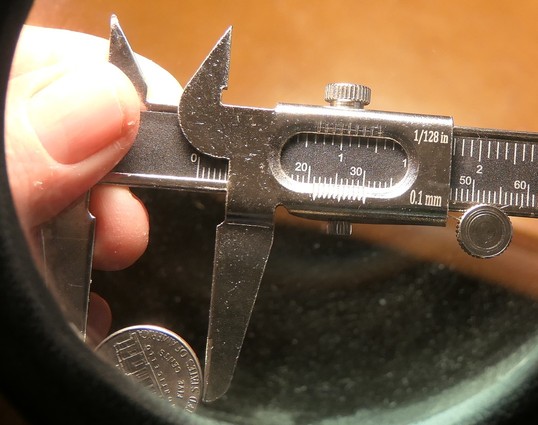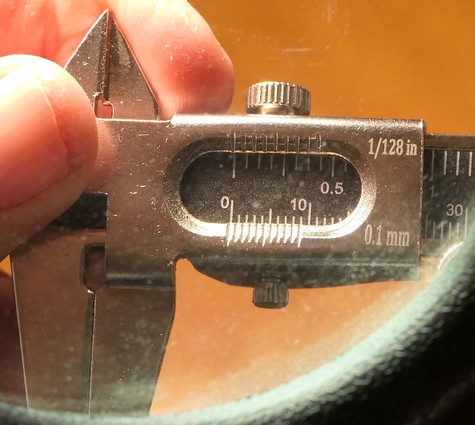This review was censored by Home Depot's robot (either because it was too long or because they prefer to sell much more expensive calipers), so I am posting its uncensored full version here.
This I a very accurate caliper. To get precision manufacturing like this for $8 is a steal, in my opinion. From the reviews, however, it seems obvious that not all people know how to read such a thing, leading to claims of inaccuracy. I can see that some peoples description does not match the picture they post.

So consider my first picture as an example. Here I am measuring the diameter of a nickel. According to the US Mint, this diameter is 0.835 inch, or 21.21 mm.
Let's do mm first. Look at the lower scale, in mm, and the *leftmost* mark on the frame below the scale. Note that this mark is pointing just to the left of the tick on the scale that indicates 21 mm. So we already see that the diameter is a bit bigger than 21 mm, and definitely smaller than 22 mm. But how much smaller? You might guess it might be 21.0, 21.1, 21.2, or 21.3, but it is hard to see with the mark and tick thicknesses as they are. There is a better way. To get the final digit look at the ten marks on the lower frame to the right of the leftmost one. *What* tick these marks are on is not important. The only thing important is which of these ten marks is exactly centered on its tick. In this case the second mark to the right of the leftmost one (so the third mark from the left in total) is right on a tick. This then means that the final digit is 2 (in other words, the mark number counting from zero) and the diameter is measured as 21.2 mm. And there is no way to measure the fourth digit, the final 1 in 21.21 with a caliper of this type. You would need a micrometer, with a rotating instead of linear scale. In fact, you might argue that the first mark (counting from 0) is really better centered than the second mark. If so, that would make the measured value 21.1 instead of 21.2. But the caliper is not quite seen straight on in the picture.
To read the diameter in inches, look at the top frame marks and to the top scale which is in 1/16 inch increments. Now 0.835 inch is 13/16 inch plus about 3/128 inch, for 107/128 of an inch total. As you see, the leftmost mark is just a bit behind the 13/16 inch tick (3 ticks before the 1 inch = 16/16 inch tick) So that is good. To get more accurate, note that the third mark, counting from zero, on the upper frame seems to be right on top of a tick. So in addition to the 13/16 inch, we have another 3/128 inch, so 107/128 inch total, for the diameter.
In short, this caliper reads accurate to about 0.1 mm, or to about 1/128 inch as it should. BTW, 0.1 mm is *not* a micron; 0.001 mm is a micron.

In the second picture, I show the reading for a zero length object, in other words, with the legs closed. Note that the leftmost top mark is on the zero inch tick, and centered on this tick, so the reading is 0/16 inch plus 0/128 inch = 0 inch at it should. You might note that the rightmost (eighth, counting from zero) mark is also centered on a tick. The rightmost mark is equivalent to the leftmost. In particular, note that if this *last* mark is centered, it does *not* mean 8/128, it means 0/128. Similar observations apply to the mm scale.